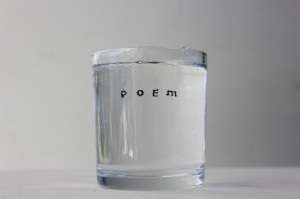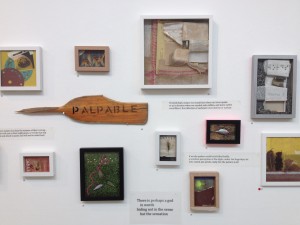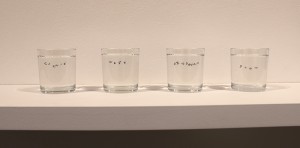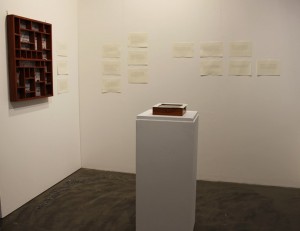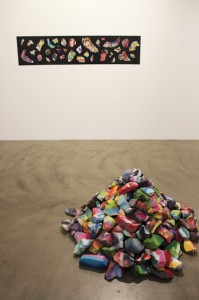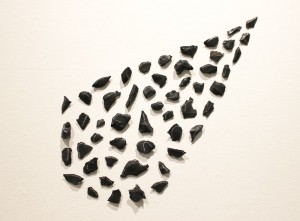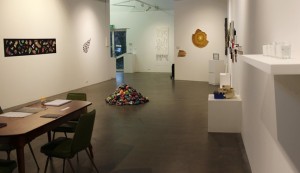review: material poetics at ANCA gallery
Walking through ‘Material Poetics’, I feel as if one hand is brushing silk, stone, water, melted butter and sandpaper, the other catching a breeze infused with ideas and emotion. In literary terms, poetics give intensity to the expression of feelings or ideas. For these artists, everything material has poetic potential. This exhibition explores the space between the thing and the expression of the thing. Language can be conceptual, but has roots in the physical world. Without the things, the thoughts would not be as real and rich.
Lineation Experiment is a pearly silk banner by Jordan Williams – a standard. Slips with lines of text are tacked on in all directions, loose threads dangle and intersect. The hem is fringed with snippets, reminding me of noticeboard advertisements edged with pull-off tags for a phone number – I resist the temptation to tear off a souvenir, though the silk’s lustre calls me to touch. Lines include fragments of poetry and instructions about the use of line breaks. I hunt for familiar meanings – this might be a poem, a puzzle, or a lesson yet to learn.
If words were is a prolific installation by Sarah Rice. Text elements focus attention on the physical qualities of words – the texture, the ways words touch us, leave an imprint, obscure or clarify. Rice is a poet who writes about the sensory effect of words. Here, in visual phrases, she matches materiality to her text. Used sandpaper, hessian, AstroTurf, feathers and fish lure the eyes and the fingertips. As I move along the installation, impressions accumulate, amplifying the force of the words.
Like a well-executed magic trick, Words by Nicci Haynes is arrestingly simple. Four glasses of clear liquid stand on a shelf. Floating within, without visible means of support, are typewritten black letters. They appear to be printed directly in the medium, dispersing a little at the edges. Slightly higgledy-piggledy, they spell words that are the building blocks of text – ‘letter’, ‘word’, and ‘sentence’. Then they leap, like this work gracefully does, to ‘poem’.
The centre of Jen Webb’s Blanche is a handwritten flyleaf inscription, dated 1914, from Blanche to Henry. Found in a copy of Walt Whitman’s Leaves of Grass, it has inspired a stream of research and exploration by Webb and her colleagues in the Prose Poetry Project. Recalling the scratch of pen and ink, the inscription lines small timber shelves, which hold pen and inkpot, a tiny chair. Lead letterpress type spills in a swath onto the floor, the past falling into the present. A series of prose poems capture different possibilities of the relationship between Blanche and Henry. Their proximity is potently evoked through the setting of the photographic studio where they worked – the smell of chemicals on skin, reliance on touch in the dark, images emerging into light.
Talking to strangers by UK Frederick and Katie Hayne, is the only work with no apparent text. Brightly coloured patches with the speckle of spray paint are assembled on a black ground, layers visible at torn edges. They are a kind of found poetry, fragments of the painted marks accumulated on rocky outcrops. Iconic sites such as the Nambucca Heads V-wall, broadcast their messages to whoever passes. A cairn of spray-painted rocks stands nearby, another landmark formed by anonymous gestures.
Love on the Rocks, also by Frederick and Hayne, is a collection of hand-chipped blades in black dacite, arranged in the shape of larger blade or a comet. Each carries a phrase in white block letters – ‘NOT PRETTY ENOUGH’, ‘YOU MAKE ME SWEAT’, ‘I FEEL SO LONELY’. These modern idioms edge ancient tools for cutting. They speak to feelings we have about ourselves and the other in the forming or failing of a love affair. The power of the phrases is in their familiarity, reminding us of the commonality of love, lust, loss and inadequacy.
A kitchen table and chairs invite me to sit with touching/reading/touch, four artists books by Caren Florance. Touch to activate looks like a charcoal rubbing and I expect to smudge black onto my fingers. But the ink is fast, applied by printing press rollers. The text speaks directly from the artist to the reader: ‘we share this space’. Mark is embossed on soft thick stock – at the right angle you can see the text, but it is a book to feel rather than see. Swipe puts the viewer inside a touch-screen – fingers press out against the pages. Touch 00100000 contains grids of forcefully typed zeros. A jar and tweezers are provided for the reader to collect the punched-out centres.
‘Material Poetics’ is a conversation about the blurring edges of poetry and art. The room brochure includes a manifesto, suggesting a collective position on those edges. But it is an expansive one, and the artists’ writings and reading list make it clear this is a conversation they want to continue – with us.
‘Material Poetics’ exhibited at the ANCA Gallery from 24 August to 11 September 2016.
Artists: Caren Florance, UK Frederick and Katie Hayne, Nicci Haynes, Sarah Rice, Jen Webb, Jordan Williams

